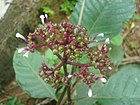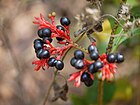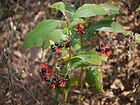Note: This is a project under development. The articles on this wiki are just being initiated and broadly incomplete. You can Help creating new pages.
Rauvolfia serpentina - Sarpa Gandha
Rauvolfia serpentina is a species of flower in the family Apocynaceae. It is native to the Indian subcontinent and East Asia from India to Indonesia.
Uses
High blood sugar, Lowering blood pressure, Cataract, Plague, Schizophrenia, Anxiety, Psychosis, Epilepsy, Colic, Cholera, Snake bite , Hypochondria, Mental disorders, Intractable skin disorder, Psoriasis.
Parts Used
Root.
Chemical Composition
Ajmaline, ajmalinine and ajmalicine, serpentine, serpentinine, alkaloids, reserpine, rescinnamine and yohimbine[1]
Common names
| Language | Common name |
|---|---|
| Kannada | Sarpagandha |
| Hindi | Sarpagandha |
| Malayalam | Suvapavalforiyan |
| Tamil | Chivan amelpodi |
| Telugu | Paataala goni |
| Marathi | NA |
| Gujarathi | NA |
| Punjabi | NA |
| Kashmiri | NA |
| Sanskrit | Sarpagandha |
| English | Snake-root |
Properties
Reference: Dravya - Substance, Rasa - Taste, Guna - Qualities, Veerya - Potency, Vipaka - Post-digesion effect, Karma - Pharmacological activity, Prabhava - Therepeutics.
Dravya
Rasa
Tikta (Bitter), Kashaya (Astringent)
Guna
Laghu (Light), Ruksha (Dry), Tikshna (Sharp)
Veerya
Ushna (Hot)
Vipaka
Katu (Pungent)
Karma
Kapha, Vata
Prabhava
Habit
Identification
Leaf
| Kind | Shape | Feature |
|---|---|---|
| Simple | In whorls of 3, thin, lanceolate, acute, bright green above and pale beneath |
Flower
| Type | Size | Color and composition | Stamen | More information |
|---|---|---|---|---|
| Unisexual | 2-4cm long | violet | 5 | Flowers are in irregular corymbose cymes, white, often tinged with violet |
Fruit
| Type | Size | Mass | Appearance | Seeds | More information |
|---|---|---|---|---|---|
| Simple | 7–10 mm | clearly grooved lengthwise, Lowest hooked hairs aligned towards crown | many | {{{6}}} |
Other features
List of Ayurvedic medicine in which the herb is used
- Vishatinduka Taila as root juice extract
Where to get the saplings
Mode of Propagation
How to plant/cultivate
Its grows spontaneous in tropical forests (temp,10°C to 40°C) which are humid in summer at an altitude up to about 1200 metres.[3]
Commonly seen growing in areas
Photo Gallery
References
External Links
- Ayurvedic Herbs known to be helpful to treat High blood sugar
- Ayurvedic Herbs known to be helpful to treat Lowering blood pressure
- Ayurvedic Herbs known to be helpful to treat Cataract
- Ayurvedic Herbs known to be helpful to treat Plague
- Ayurvedic Herbs known to be helpful to treat Schizophrenia
- Ayurvedic Herbs known to be helpful to treat Anxiety
- Ayurvedic Herbs known to be helpful to treat Psychosis
- Ayurvedic Herbs known to be helpful to treat Epilepsy
- Ayurvedic Herbs known to be helpful to treat Colic
- Ayurvedic Herbs known to be helpful to treat Cholera
- Ayurvedic Herbs known to be helpful to treat Snake bite
- Ayurvedic Herbs known to be helpful to treat Hypochondria
- Ayurvedic Herbs known to be helpful to treat Mental disorders
- Ayurvedic Herbs known to be helpful to treat Intractable skin disorder
- Ayurvedic Herbs known to be helpful to treat Psoriasis
- Herbs with Root used in medicine
- Herbs with common name in Kannada
- Herbs with common name in Hindi
- Herbs with common name in Malayalam
- Herbs with common name in Tamil
- Herbs with common name in Telugu
- Herbs with common name in Sanskrit
- Herbs with common name in English
- Habit - Herb
- Index of Plants which can be propagated by Seeds
- Index of Plants which can be propagated by Cuttings
- Herbs that are commonly seen in the region of Trophical region
- Herbs that are commonly seen in the region of Borders of forests and fields
- Herbs







